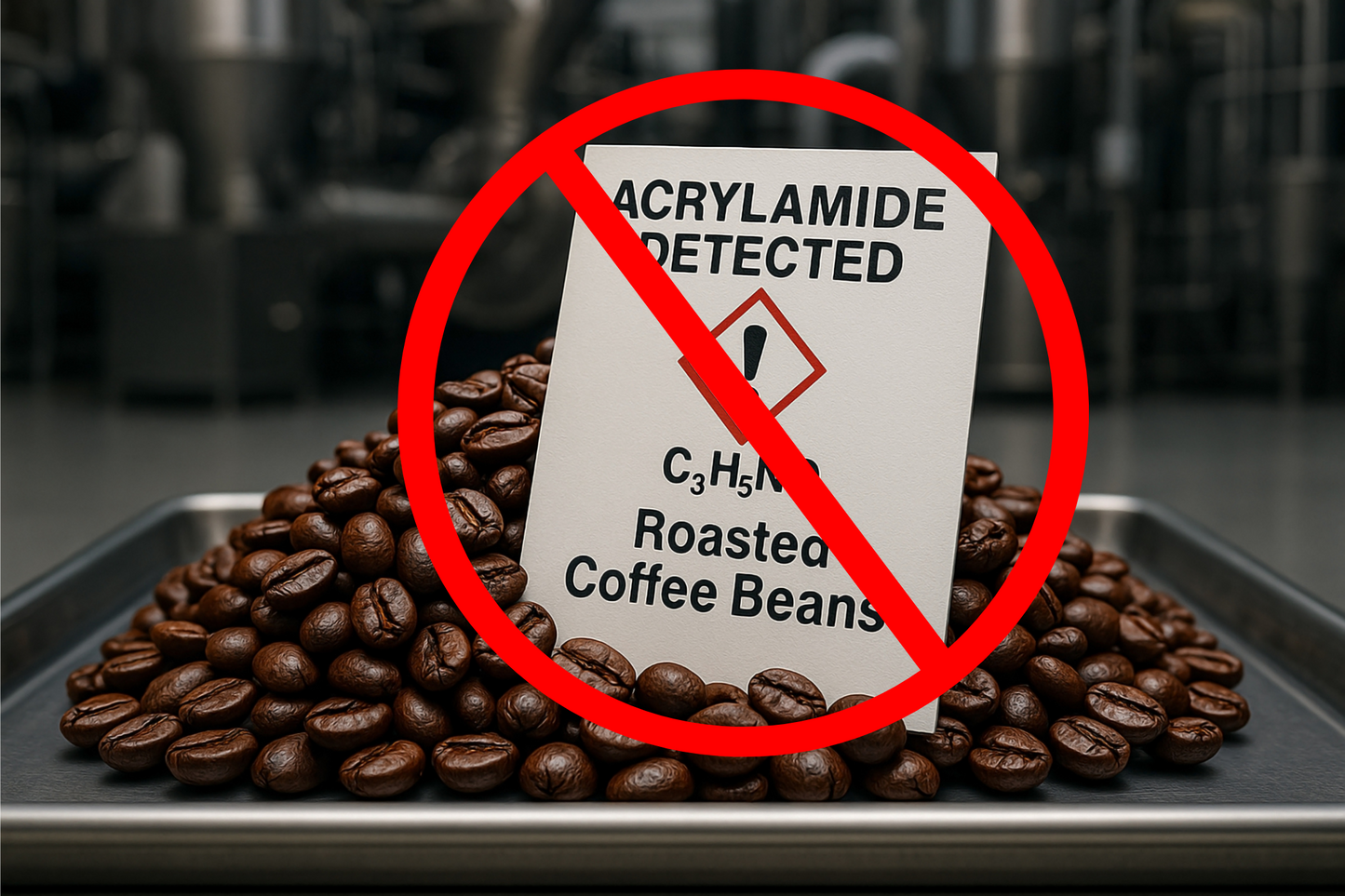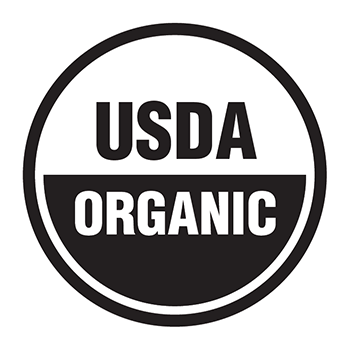Buy your weekday smoothies and get your weekend ones for free. (7 for the price of 5!)

Truista Coffee is the first brand to lower levels of acrylamide to “undetectable” levels tested under ISO/ IEC 17025:2017.
What is acrylamide and why does it form in coffee?
Acrylamide is a process contaminant that develops in certain plant-based foods during high-temperature cooking. It forms primarily when the amino acid asparagine reacts with reducing sugars such as glucose or fructose in what is known as the Maillard reaction. This is the reaction that gives roasted foods their brown color and complex flavors. The process accelerates above about 120 °C (248 °F) and occurs most readily under low- moisture conditions, which is exactly the type of environment present during coffee roasting.
Scientific research has shown that high levels of acrylamide can cause cancer in animals, which has led health agencies to consider it a potential risk for humans. While small amounts are present in many everyday foods, including coffee, the highest concentrations are often found in items like potato chips and French fries. Long term exposure through diet is what raises concern, because repeated consumption of foods with measurable acrylamide can add up over time. That is why regulatory agencies like California’s Proposition 65 and the European Food Safety Authority have highlighted acrylamide as a contaminant that consumers should limit whenever possible.
Truista Coffee - Acrylamide-Free*
The founder could not find any coffee brands without Acrylamide. This was the main driver for the creation of Truista. Unlike other coffee brands, because we address the problem of acrylamide at its source. At the very farms where our beans are grown and harvested, we apply a proprietary process that is completely natural, USDA organic, and unique to us alone. This method works at the raw bean stage to transform the compounds that would otherwise create harmful byproducts during roasting. The result is a coffee that not only meets the highest organic standards, but also reduces acrylamide to levels below what even the most advanced laboratories can detect. No other company in the world can claim this process (and be USDA Organic). It is our signature commitment to purity and safety.
Acrylamide and the MTHFR gene mutation
A large portion of the population (approx 40-60 worldwide) carries a genetic variation in the MTHFR enzyme, which plays a key role in how the body processes and removes toxins. People with this mutation have a reduced ability to properly methylate, a critical step for detoxification. When acrylamide enters the body through food or drink, those with the MTHFR mutation may be less efficient at breaking it down and clearing it. Over time, this can allow acrylamide to accumulate, raising the risk of side effects. Reported issues linked with high acrylamide exposure include headaches, fatigue, difficulty concentrating, tingling or numbness in the hands and feet, and in some cases, problems with mood, memory, and sleep. See references below. These concerns make it especially important for individuals with MTHFR mutations to seek out acrylamide-free* coffee and other cleaner food choices to reduce unnecessary toxic burden.
Proposition 65 and coffee
California’s Proposition 65 lists acrylamide as a chemical known to cause cancer. This is why many cafés and coffee brands once displayed warning signs. In 2019, California regulators reversed course and declared that coffee no longer required a cancer warning under Proposition 65, despite years of scientific evidence pointing to acrylamide as a probable carcinogen. For consumers, this sudden shift raises serious questions. If the science had not changed, what did? When a product as central to the U.S. economy as coffee is given a regulatory pass, it is difficult not to wonder whether protecting commerce outweighed protecting public health.
How laboratories measure acrylamide in coffee
Modern food laboratories use liquid chromatography coupled with tandem mass spectrometry and an isotopically labeled internal standard to detect and quantify acrylamide with precision. Testing often includes QuEChERS extraction and solid-phase cleanup for solids.
Two important terms are always considered:
- LOD (Limit of Detection), which is the smallest concentration a method can reliably detect.
- LOQ (Limit of Quantitation), which is the smallest concentration that can be measured with accuracy and precision.
Results that fall below the LOD are typically reported as “ND,” meaning non-detect. For brewed coffee, validated methods have shown LOQs near one microgram per liter, while LOD values depend on the method used.
What Acrylamide Free* Coffee means at Truista
Brands historically avoided the term “acrylamide free*” because testing occurs at parts-per-billion and science rarely claims absolute zero. Truista defines acrylamide free* coffee as brewed coffee that tests non-detect for acrylamide using accredited independent LC-MS/MS laboratories with industry-standard detection limits. Every production lot is tested and published.
- ND does not mean zero. “Acrylamide free*” is defined as non-detectable in brewed coffee by accredited LC- MS/MS laboratories. See certificates for details.
Declaration for “Acrylamide-Free*”
*Tested under ISO/IEC 17025:2017. Acrylamide present at the lowest levels detectable by accredited lab methods at time of testing liquid coffee sample brewed at 1.25% TDS.
Total transparency
Every batch of Truista coffee has a Certificate of Analysis available to customers. You can scan the QR code printed on the back of the bag to access our certificates page, then look up your roast ID (printed next to roast date) to download the exact lab report.
Why Truista achieves non-detect results in brewed coffee
Truista developed its process with a focus on precursor control and careful roast management. By managing the availability of asparagine and carefully controlling the roast progression, we reduce formation in the early roast stage where acrylamide levels peak, while maintaining cup quality. The outcome is straightforward. Brewed Truista Coffee tests as non-detect for acrylamide under our laboratory conditions. Published scientific literature supports the principle that precursor control and roast management lower acrylamide formation.
Truista remains the only coffee brand without acrylamide, proven by COAs published on every roast batch they process.
References on Acrylamide Symptoms and Toxicity
ATSDR – ToxFAQsTM for Acrylamide
Agency for Toxic Substances and Disease Registry (CDC). Summarizes human
health effects, including neurological and reproductive impacts.
https://wwwn.cdc.gov/TSP/ToxFAQs/ToxFAQsDetails.aspx?
faqid=1162&toxid=236
Neurotoxicity of Acrylamide in Exposed Workers
Pennisi, M., Malaguarnera, G., Puglisi, V., Vinciguerra, L., Vacante, M.,
Malaguarnera, M. (2013). International Journal of Environmental Research and
Public Health.
https://pmc.ncbi.nlm.nih.gov/articles/PMC3799507/
Occupational Neurological and Dermal Toxicity of Acrylamide
Kim, E.A., Lee, J.H., Lee, C.R., Kang, S.K. (2017). Annals of Occupational and Environmental Medicine.
https://aoemj.biomedcentral.com/articles/10.1186/s40557-017-0207-7
Toxicological Profile for Acrylamide (Draft for Public Comment)
Agency for Toxic Substances and Disease Registry (ATSDR), 2012.
https://www.atsdr.cdc.gov/toxprofiles/tp203-c2.pdf
Occupational Exposure to Acrylamide and Peripheral Neuropathy
Hagmar, L., Törnqvist, M., Nordander, C., et al. (2001). Scandinavian Journal of
Work, Environment & Health.
https://www.ncbi.nlm.nih.gov/books/NBK591426/
A Review on Acrylamide in Food: Occurrence, Toxicity, and Mitigation Strategies
Rifai, L., Saleh, F.A., Badr, A., & Shaheen, R. (2020). Food Science and
Technology International.
https://journals.sagepub.com/doi/full/10.1177/1091581820902405
Acute Acrylamide Poisoning with Severe Symptoms in a Short Time: A Case
Report
Yamamoto, K., Morimoto, Y., Ueyama, J., et al. (2023). International Journal of
Emergency Medicine.
https://intjem.biomedcentral.com/articles/10.1186/s12245-023-00514-z





